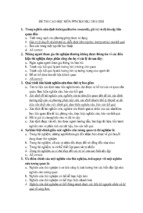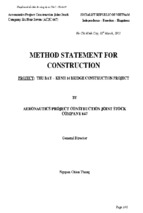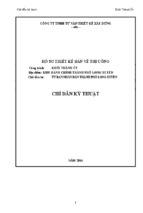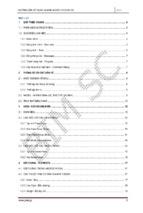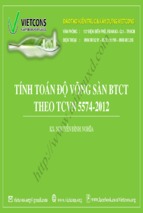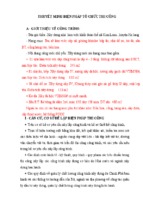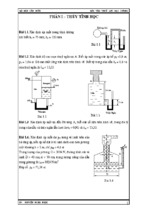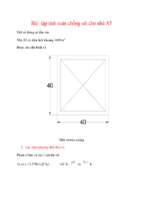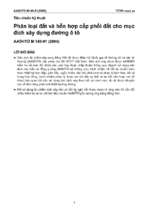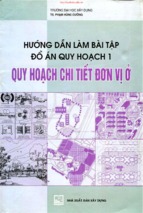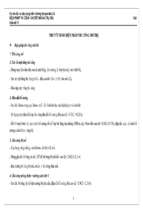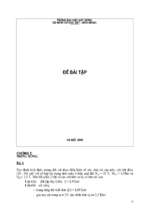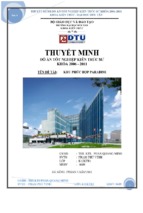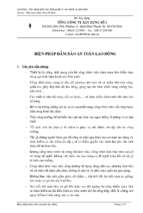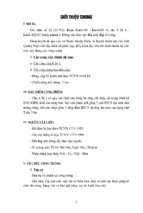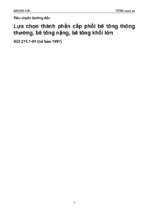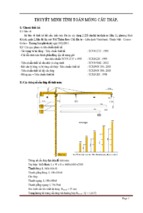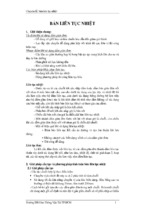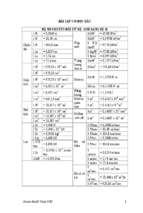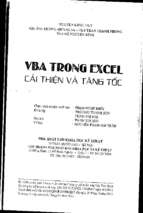Wind-Induced Vibration
of Stay Cables
Publication No. FHWA-HRT-05-083 August 2007
Research, Development, and Technology
Turner-Fairbank Highway Research Center
6300 Georgetown Pike
McLean, VA 22101-2296
Foreword
Cable-stayed bridges have become the form of choice over the past several decades for bridges
in the medium- to long-span range. In some cases, serviceability problems involving large
amplitude vibrations of stay cables under certain wind and rain conditions have been observed.
This study was conducted to develop a set of consistent design guidelines for mitigation of
excessive cable vibrations on cable-stayed bridges.
The project team started with a thorough review of existing literature; this review indicated that
while the rain/wind problem is known in sufficient detail, galloping of dry inclined cables was
the most critical wind-induced vibration mechanism in need of further experimental research. A
series of wind tunnel tests was performed to study this mechanism. Analytical and experimental
research was performed to study mitigation methods, covering a range of linear and nonlinear
dampers and crossties. The study also included brief studies on live load-induced vibrations and
establishing driver/pedestrian comfort criteria.
Based on the above, design guidelines for the mitigation of wind-induced vibrations of stay
cables were developed. As a precautionary note, the state of the art in stay cable vibration
mitigation is not an exact science. These new guidelines are only intended for use by
professionals with experience in cable-stayed bridge design, analysis, and wind engineering, and
should only be applied with engineering judgment and due consideration of special conditions
surrounding each project.
Gary L. Henderson
Office of Infrastructure Research
and Development
Notice
This document is disseminated under the sponsorship of the U.S. Department of Transportation
in the interest of information exchange. The U.S. Government assumes no liability for the use of
the information contained in this document. This report does not constitute a standard,
specification, or regulation.
The U.S. Government does not endorse products or manufacturers. Trademarks or
manufacturers' names appear in this report only because they are considered essential to the
objective of the document.
Quality Assurance Statement
The Federal Highway Administration (FHWA) provides high-quality information to serve
Government, industry, and the public in a manner that promotes public understanding. Standards
and policies are used to ensure and maximize the quality, objectivity, utility, and integrity of its
information. FHWA periodically reviews quality issues and adjusts its programs and processes to
ensure continuous quality improvement.
1. Report No.
2. Government Accession No.
FHWA-RD-05-083
4. Title and Subtitle
Wind-Induced Vibration of Stay Cables
7. Author(s)
Sena Kumarasena, Nicholas P. Jones, Peter Irwin, Peter Taylor
9. Performing Organization Name and Address
Primary Consultant:
HNTB Corporation
75 State St., Boston, MA 02109
352 Seventh Ave., 6th Floor, New York, NY 10001-5012
Technical Report Documentation Page
3. Recipient’s Catalog No.
5. Report Date
August 2007
6. Performing Organization Code
8. Performing Organization Report No.
10. Work Unit No.
11. Contract or Grant No.
DTFH61-99-C-00095
In association with:
John Hopkins University
Dept. of Civil Engineering, Baltimore, MD 21218-2686
Rowan Williams Davies and Irwin, Inc.
650 Woodlawn Road West, Guelph, Ontario N1K 1B8
Buckland and Taylor, Ltd.
Suite 101, 788 Harborside Drive, North Vancouver, BC V7P3R7
12. Sponsoring Agency Name and Address
13. Type of Report and Period Covered
Office of Infrastructure R&D
Final Report
Federal Highway Administration
September 1999 to December 2002
6300 Georgetown Pike
14. Sponsoring Agency Code
McLean, VA 22101-2296
15. Supplementary Notes
Contracting Officer’s Technical Representative (COTR) Harold Bosch, HRDI-07
16. Abstract
Cable-stayed bridges have become the form of choice over the past several decades for bridges in the medium- to
long-span range. In some cases, serviceability problems involving large amplitude vibrations of stay cables under
certain wind and rain conditions have been observed. This study was conducted to develop a set of consistent design
guidelines for mitigation of excessive cable vibrations on cable-stayed bridges.
To accomplish this objective, the project team started with a thorough review of existing literature to determine the
state of knowledge and identify any gaps that must be filled to enable the formation of a consistent set of design
recommendations. This review indicated that while the rain/wind problem is known in sufficient detail, galloping of dry
inclined cables was the most critical wind-induced vibration mechanism in need of further experimental research. A
series of wind tunnel tests was performed to study this mechanism. Analytical and experimental research was
performed to study mitigation methods, covering a range of linear and nonlinear dampers and crossties. The study
also included brief studies on live load-induced vibrations and establishing driver/pedestrian comfort criteria.
Based on the above, design guidelines for mitigation of wind-induced vibrations of stay cables were developed.
17. Key Words
18. Distribution Statement
cable-stayed bridge, cables, vibrations, wind,
No restrictions. This document is available to the public through
rain, dampers, crossties
the National Technical Information Service, Springfield, VA 22161
19. Security Classif. (of this report)
20. Security Classif. (of this page)
21. No of Pages 22. Price
Unclassified
Unclassified
281
Form DOT F 1700.7 (8-72)
Reproduction of completed pages authorized
SI* (MODERN METRIC) CONVERSION FACTORS
APPROXIMATE CONVERSIONS TO SI UNITS
Symbol
When You Know
in
ft
yd
mi
inches
feet
yards
miles
Multiply By
LENGTH
25.4
0.305
0.914
1.61
To Find
Symbol
millimeters
meters
meters
kilometers
mm
m
m
km
square millimeters
square meters
square meters
hectares
square kilometers
mm
m2
2
m
ha
km2
AREA
2
in
ft2
2
yd
ac
mi2
square inches
square feet
square yard
acres
square miles
645.2
0.093
0.836
0.405
2.59
fl oz
gal
ft3
3
yd
fluid ounces
gallons
cubic feet
cubic yards
oz
lb
T
ounces
pounds
short tons (2000 lb)
o
Fahrenheit
fc
fl
foot-candles
foot-Lamberts
lbf
lbf/in2
poundforce
poundforce per square inch
Symbol
When You Know
mm
m
m
km
millimeters
meters
meters
kilometers
2
VOLUME
29.57
milliliters
3.785
liters
0.028
cubic meters
0.765
cubic meters
3
NOTE: volumes greater than 1000 L shall be shown in m
mL
L
m3
3
m
MASS
28.35
0.454
0.907
grams
kilograms
megagrams (or "metric ton")
TEMPERATURE (exact degrees)
F
5 (F-32)/9
or (F-32)/1.8
g
kg
Mg (or "t")
Celsius
o
lux
2
candela/m
lx
2
cd/m
C
ILLUMINATION
10.76
3.426
FORCE and PRESSURE or STRESS
4.45
6.89
newtons
kilopascals
N
kPa
APPROXIMATE CONVERSIONS FROM SI UNITS
2
Multiply By
LENGTH
0.039
3.28
1.09
0.621
To Find
Symbol
inches
feet
yards
miles
in
ft
yd
mi
square inches
square feet
square yards
acres
square miles
in
2
ft
2
yd
ac
mi2
fluid ounces
gallons
cubic feet
cubic yards
fl oz
gal
3
ft
3
yd
ounces
pounds
short tons (2000 lb)
oz
lb
T
AREA
mm
2
m
2
m
ha
km2
square millimeters
square meters
square meters
hectares
square kilometers
0.0016
10.764
1.195
2.47
0.386
mL
L
3
m
3
m
milliliters
liters
cubic meters
cubic meters
g
kg
Mg (or "t")
grams
kilograms
megagrams (or "metric ton")
o
Celsius
2
VOLUME
0.034
0.264
35.314
1.307
MASS
C
0.035
2.202
1.103
TEMPERATURE (exact degrees)
1.8C+32
Fahrenheit
o
foot-candles
foot-Lamberts
fc
fl
F
ILLUMINATION
lx
cd/m2
lux
candela/m2
N
kPa
newtons
kilopascals
0.0929
0.2919
FORCE and PRESSURE or STRESS
0.225
0.145
poundforce
poundforce per square inch
lbf
2
lbf/in
*SI is the symbol for the International System of Units. Appropriate rounding should be made to comply with Section 4 of ASTM E380.
(Revised March 2003)
ii
TABLE OF CONTENTS
EXECUTIVE SUMMARY .....................................................................................1
CHAPTER 1. INTRODUCTION ...........................................................................5
BACKGROUND ....................................................................................................................... 5
PROJECT OBJECTIVES AND TASKS................................................................................ 7
CHAPTER 2. COMPILATION OF EXISTING INFORMATION ...................9
REFERENCE MATERIALS................................................................................................... 9
INVENTORY OF U.S. CABLE-STAYED BRIDGES .......................................................... 9
CHAPTER 3. ANALYSIS, EVALUATION, AND TESTING ..........................11
MECHANICS OF WIND-INDUCED VIBRATIONS ........................................................ 11
Reynolds Number................................................................................................................ 11
Strouhal Number ................................................................................................................ 11
Scruton Number.................................................................................................................. 12
Vortex Excitation of an Isolated Cable and Groups of Cables....................................... 12
Rain/Wind-Induced Vibrations ......................................................................................... 13
Wake Galloping for Groups of Cables.............................................................................. 14
Galloping of Dry Inclined Cables .......................................................................................15
WIND TUNNEL TESTING OF DRY INCLINED CABLES............................................. 16
Introduction......................................................................................................................... 16
Testing.................................................................................................................................. 17
Results Summary ................................................................................................................ 18
OTHER EXCITATION MECHANISMS ............................................................................ 20
Effects Due to Live Load .................................................................................................... 20
Deck-Stay Interaction Because of Wind ........................................................................... 21
STUDY OF MITIGATION METHODS .............................................................................. 23
Linear and Nonlinear Dampers......................................................................................... 23
Linear Dampers .................................................................................................................. 24
Nonlinear Dampers............................................................................................................. 25
Field Performance of Dampers.......................................................................................... 26
Crosstie Systems.................................................................................................................. 28
Analysis ................................................................................................................................ 30
Field Performance............................................................................................................... 33
Considerations for Crosstie Systems................................................................................. 35
Cable Surface Treatment ................................................................................................... 36
FIELD MEASUREMENTS OF STAY CABLE DAMPING.............................................. 37
Leonard P. Zakim Bunker Hill Bridge (over Charles River in Boston, MA) ............... 37
Sunshine Skyway Bridge (St. Petersburg, FL)................................................................. 40
BRIDGE USER TOLERANCE LIMITS ON STAY CABLE VIBRATION.................... 42
iii
CHAPTER 4. DESIGN GUIDELINES ...............................................................45
NEW CABLE-STAYED BRIDGES...................................................................................... 45
General................................................................................................................................. 45
Mitigation of Rain/Wind Mechanism................................................................................ 45
Additional Mitigation ......................................................................................................... 45
Minimum Scruton Number................................................................................................ 45
External Dampers ............................................................................................................... 46
Cable Crossties .................................................................................................................... 46
User Tolerance Limits ........................................................................................................ 47
RETROFIT OF EXISTING BRIDGES ............................................................................... 47
WORKED EXAMPLES......................................................................................................... 48
Example 1 ............................................................................................................................ 48
Example 2 ............................................................................................................................ 52
CHAPTER 5. RECOMMENDATIONS FOR FUTURE RESEARCH AND
DEVELOPMENT ..................................................................................................55
WIND TUNNEL TESTING OF DRY INCLINED CABLES............................................. 55
DECK-INDUCED VIBRATION OF STAY CABLES........................................................ 55
MECHANICS OF RAIN/WIND-INDUCED VIBRATIONS ............................................. 55
DEVELOP A MECHANICS-BASED MODEL FOR STAY CABLE VIBRATION
ENABLING THE PREDICTION OF ANTICIPATED VIBRATION
CHARACTERISTICS............................................................................................................ 56
PREDICT THE PERFORMANCE OF STAY CABLES AFTER MITIGATION USING
THE MODEL .......................................................................................................................... 57
PERFORM A DETAILED QUANTITATIVE ASSESSMENT OF VARIOUS
ALTERNATIVE MITIGATION STRATEGIES................................................................ 58
IMPROVE UNDERSTANDING OF INHERENT DAMPING IN STAYS AND THAT
PROVIDED BY EXTERNAL DEVICES............................................................................. 58
IMPROVE UNDERSTANDING OF CROSSTIE SOLUTIONS....................................... 59
REFINE RECOMMENDATIONS FOR EFFECTIVE AND ECONOMICAL DESIGN
OF STAY CABLE VIBRATION MITIGATION STRATEGIES FOR FUTURE
BRIDGES................................................................................................................................. 59
APPENDIX A. DATABASE OF REFERENCE MATERIALS .......................61
APPENDIX B. INVENTORY OF U.S. CABLE-STAYED BRIDGES ............81
APPENDIX C. WIND-INDUCED CABLE VIBRATIONS ..............................87
APPENDIX D. WIND TUNNEL TESTING OF STAY CABLES................. 101
iv
APPENDIX E. LIST OF TECHNICAL PAPERS........................................... 153
APPENDIX F. ANALYTICAL AND FIELD INVESTIGATIONS .............. 155
APPENDIX G. INTRODUCTION TO MECHANICS OF INCLINED
CABLES............................................................................................................... 213
APPENDIX H. LIVE-LOAD VIBRATION SUBSTUDY .............................. 225
APPENDIX I. STUDY OF USER COMFORT ............................................... 257
REFERENCES AND OTHER SOURCES....................................................... 261
v
LIST OF FIGURES
Figure 1. Graph. Comparison of wind velocity-damping relation of inclined dry cable.............. 19
Figure 2. Graph. Cable M26, tension versus time (transit train speed = 80 km/h (50 mi/h))....... 20
Figure 3. Graph. Time history and power spectral density (PSD) of the first 2 Hz
for deck at midspan (vertical direction). ................................................................................. 22
Figure 4. Graph. Time history and power spectral density (PSD) of the first 2 Hz
for cable at AS24 (in-plane direction) deck level wind speed. ............................................... 22
Figure 5. Deck level wind speed................................................................................................... 22
Figure 6. Photo. Damper at cable anchorage. ............................................................................... 23
Figure 7. Drawing. Taut cable with linear damper. ...................................................................... 24
Figure 8. Graph. Normalized damping ratio versus normalized damper coefficient: Linear
damper..................................................................................................................................... 25
Figure 9. Graph. Normalized damping ratio versus normalized damper coefficient (β = 0.5)..... 26
Figure 10. Photo. Fred Hartman Bridge........................................................................................ 27
Figure 11. Photo. Cable crosstie system. ...................................................................................... 29
Figure 12. Photo. Dames Point Bridge. ........................................................................................ 30
Figure 13. Chart. General problem formulation. .......................................................................... 31
Figure 14. Chart. General problem formulation (original configuration)..................................... 31
Figure 15. Graph. Eigenfunctions of the network equivalent to Fred Hartman Bridge: Mode 1. 32
Figure 16. Graph. Eigenfunctions of the network equivalent to Fred Hartman Bridge: Mode 5. 32
Figure 17. Graph. Comparative analysis of network vibration characteristics and individual
cable behavior: Fred Hartman Bridge..................................................................................... 33
Figure 18. Chart. Fred Hartman Bridge, field performance testing arrangement......................... 34
Figure 19. Drawing. Types of cable surface treatments. .............................................................. 36
Figure 20. Graph. Example of test data for spiral bead cable surface treatment. ......................... 37
Figure 21. Photo. Leonard P. Zakim Bunker Hill Bridge............................................................. 37
Figure 22. Graph. Sample decay: No damping and no crossties. ................................................. 39
Figure 23. Graph. Sample decay: With damping and no crossties. .............................................. 39
Figure 24. Graph. Sample decay: With damping and crossties. ................................................... 40
Figure 25. Photo. Sunshine Skyway Bridge. ................................................................................ 40
Figure 26. Photo. Stay and damper brace configuration............................................................... 41
Figure 27. Photo. Reference database search page. ...................................................................... 61
Figure 28. Photo. Reference database search results page............................................................ 62
Figure 29. Photo. U.S. cable-stayed bridge database: Switchboard. ............................................ 82
Figure 30. Photo. U.S. cable-stayed bridge database: General bridge information...................... 83
Figure 31. Photo. U.S. cable-stayed bridge database: Cable data................................................. 84
Figure 32. Photo. U.S. cable-stayed bridge database: Wind data. ................................................ 85
Figure 33. Graph. Galloping of inclined cables............................................................................ 92
Figure 34. Drawing. Aerodynamic devices. ................................................................................. 94
Figure 35. Drawing. Cable crossties. ............................................................................................ 98
Figure 36. Drawing. Viscous damping. ........................................................................................ 98
Figure 37. Drawing. Material damping......................................................................................... 99
vi
Figure 38. Drawing. Angle relationships between stay cables and natural wind (after
Irwin et al.).(27) ...................................................................................................................... 103
Figure 39. Photo. Cable supporting rig: Top. ............................................................................. 105
Figure 40. Photo. Cable supporting rig: Bottom......................................................................... 105
Figure 41. Drawing. Longitudinal section of the propulsion wind tunnel.................................. 107
Figure 42. Drawing. Cross section of the working section of propulsion wind tunnel. ............. 108
Figure 43. Photo. Data acquisition system.................................................................................. 109
Figure 44. Photo. Airpot damper. ............................................................................................... 111
Figure 45. Drawing. Cross section of airpot damper. ................................................................. 112
Figure 46. Photo. Elastic bands on the spring coils. ................................................................... 113
Figure 47. Drawing. Side view of setups 1B and 1C.................................................................. 115
Figure 48. Drawing. Side view of setups 2A and 2C.................................................................. 116
Figure 49. Drawing. Side view of setups 3A and 3C.................................................................. 117
Figure 50. Photo. Cable setup in wind tunnel for testing............................................................ 118
Figure 51. Graph. Amplitude-dependent damping (A, sway; B, vertical) with setup 2C
(smooth surface, low damping)............................................................................................. 125
Figure 52. Graph. Divergent response of inclined dry cable (setup 2C; smooth surface, low
damping). .............................................................................................................................. 126
Figure 53. Graph. Lower end X-motion, time history of setup 2C at U = 32 m/s (105 ft/s). ..... 126
Figure 54. Graph. Top end X-motion, time history of setup 2C at U = 32 m/s (105 ft/s). ......... 127
Figure 55. Graph. Lower end Y-motion, time history of setup 2C at U = 32 m/s (105 ft/s). ..... 127
Figure 56. Graph. Top end Y-motion, time history of setup 2C at U = 32 m/s (105 ft/s). ......... 128
Figure 57. Graph. Trajectory of setup 2C at U = 32 m/s (105 ft/s). ........................................... 128
Figure 58. Graph. Lower end X-motion, time history of setup 2A at U = 18 m/s (59 ft/s) in
the first 5 minutes.................................................................................................................. 129
Figure 59. Graph. Top end X-motion, time history of setup 2A at U = 18 m/s (59 ft/s) in
the first 5 minutes.................................................................................................................. 129
Figure 60. Graph. Lower end Y-motion, time history of setup 2A at U = 18 m/s (59 ft/s) in
the first 5 minutes.................................................................................................................. 130
Figure 61. Graph. Top end Y-motion, time history of setup 2A at U = 18 m/s (59 ft/s) in
the first 5 minutes.................................................................................................................. 130
Figure 62. Graph. Lower end X-motion, time history of setup 2A at U = 18 m/s (59 ft/s) in
second 5 minutes................................................................................................................... 131
Figure 63. Graph. Top end X-motion, time history of setup 2A at U = 18 m/s (59 ft/s) in
second 5 minutes................................................................................................................... 131
Figure 64. Graph. Lower end Y-motion, time history of setup 2A at U = 18 m/s (59 ft/s) in
second 5 minutes................................................................................................................... 132
Figure 65. Graph. Top end Y-motion, time history of setup 2A at U = 18 m/s (59 ft/s) in
second 5 minutes................................................................................................................... 132
Figure 66. Graph. Lower end X-motion, time history of setup 2A at U = 19 m/s (62 ft/s)........ 133
Figure 67. Graph. Top end X-motion, time history of setup 2A at U = 19 m/s (62 ft/s)............ 133
Figure 68. Graph. Lower end Y-motion, time history of setup 2A at U = 19 m/s (62 ft/s)........ 134
Figure 69. Graph. Top end Y-motion, time history of setup 2A at U = 19 m/s (62 ft/s)............ 134
Figure 70. Graph. Lower end X-motion, time history of setup 1B at U = 24 m/s (79 ft/s). ....... 135
Figure 71. Graph. Top end X-motion, time history of setup 1B at U = 24 m/s (79 ft/s). ........... 135
vii
Figure 72. Graph. Lower end Y-motion, time history of setup 1B at U = 24 m/s (79 ft/s). ....... 136
Figure 73. Graph. Top end Y-motion, time history of setup 1B at U = 24 m/s (79 ft/s). ........... 136
Figure 74. Graphic. Lower end X-motion, time history of setup 1C at U = 36 m/s (118 ft/s). .. 137
Figure 75. Graph. Top end X-motion, time history of setup 1C at U = 36 m/s (118 ft/s). ......... 137
Figure 76. Graph. Lower end Y-motion, time history of setup 1C at U = 36 m/s (118 ft/s). ..... 138
Figure 77. Graph. Top end Y-motion, time history of setup 1C at U = 36 m/s (118 ft/s). ......... 138
Figure 78. Graph. Lower end X-motion, time history of setup 3A at U = 22 m/s (72 ft/s)........ 139
Figure 79. Graph. Top end X-motion, time history of setup 3A at U = 22 m/s (72 ft/s)............ 139
Figure 80. Graph. Lower end Y-motion, time history of setup 3A at U = 22 m/s (72 ft/s)........ 140
Figure 81. Graph. Top end Y-motion, time history of setup 3A at U = 22 m/s (72 ft/s)............ 140
Figure 82. Graph. Trajectory of setup 2A at U = 18 m/s (59 ft/s), first 5 minutes. .................... 141
Figure 83. Graph. Trajectory of setup 2A at U = 18 m/s (59 ft/s), second 5 minutes. ............... 141
Figure 84. Graphic. Trajectory of setup 2A at U = 19 m/s (62 ft/s). .......................................... 142
Figure 85. Graphic. Trajectory of setup 1B at U = 24 m/s (79 ft/s). .......................................... 142
Figure 86. Graphic. Trajectory of setup 1C at U = 36 m/s (119 ft/s). ........................................ 143
Figure 87. Graph. Trajectory of setup 3A at U = 22 m/s (72 ft/s). ............................................. 143
Figure 88. Graph. Wind-induced response of inclined dry cable
(setup 2A; smooth surface, low damping). ........................................................................... 144
Figure 89. Graph. Wind-induced response of inclined dry cable
(setup 1B; smooth surface, low damping). ........................................................................... 144
Figure 90. Graph. Wind-induced response of inclined dry cable
(setup 1C; smooth surface, low damping). ........................................................................... 145
Figure 91. Graph. Wind-induced response of inclined dry cable
(setup 3A; smooth surface, low damping). ........................................................................... 145
Figure 92. Graph. Wind-induced response of inclined dry cable
(setup 3B; smooth surface, low damping). ........................................................................... 146
Figure 93. Graph. Critical Reynolds number of circular cylinder (from Scruton).(27) ................ 146
Figure 94. Graph. Damping trace of four different levels of damping
(setup 1B; smooth surface). .................................................................................................. 147
Figure 95. Graph. Effect of structural damping on the wind response of inclined cable
(setup 1B; smooth surface). .................................................................................................. 147
Figure 96. Graph. Surface roughness effect on wind-induced response of dry inclined cable
(setup 3A; low damping). ..................................................................................................... 148
Figure 97. Graph. Surface roughness effect on wind-induced response of dry inclined cable
(setup 1B; low damping)....................................................................................................... 148
Figure 98. Graph. Surface roughness effect on wind-induced response of dry inclined cable
(setup 2A; low damping). ..................................................................................................... 149
Figure 99. Graph. Amplitude-dependent damping in the X-direction with setup 2A
(frequency ratio effect). ........................................................................................................ 149
Figure 100. Graph. Amplitude-dependent damping in the Y-direction with setup 2A
(frequency ratio effect). ........................................................................................................ 150
Figure 101. Graph. Wind-induced response of inclined cable in the X-direction with
setup 2A (frequency ratio effect). ......................................................................................... 150
Figure 102. Graph. Wind-induced response of inclined cable in the Y-direction with
setup 2A (frequency ratio effect). ......................................................................................... 151
viii
Figure 103. Graph. Comparison of wind velocity-damping relation of inclined dry cable........ 151
Figure 104. Chart. Taut cable with a linear damper. .................................................................. 157
Figure 105. Graph. Normalized damping ratio versus normalized damper coefficient.............. 159
Figure 106. Chart. Cable with attached friction/viscous damper................................................ 161
Figure 107. Chart. Force-velocity curve for friction/viscous damper. ....................................... 161
Figure 108. Graph. Normalized damping ratio versus clamping ratio. ...................................... 163
Figure 109. Graph. Normalized viscous damper coefficient versus clamping ratio................... 163
Figure 110. Graph. Relationship between nondimensional parameters μ and κ with different
values of the clamping ratio Θci for a friction/viscous damper............................................. 165
Figure 111. Graphic. Normalized damping ratio versus κ with varying μ................................. 166
Figure 112. Graph. Normalized damping ratio versus normalized damper coefficient
(β = 0.5)................................................................................................................................. 168
Figure 113. Graph. Normalized damping ratio versus mode ratio (β = 1).................................. 170
Figure 114. Graph. Normalized damping ratio versus amplitude ratio (β = 0.5). ...................... 170
Figure 115. Graph. Normalized damping ratio versus mode-amplitude ratio (β = 0). ............... 170
Figure 116. Chart. General problem formulation. ...................................................................... 173
Figure 117. Chart. General problem formulation (original configuration)................................. 176
Figure 118. Graph. Eigenfunctions of the network equivalent to Fred Hartman Bridge
(1st–8th modes)..................................................................................................................... 178
Figure 119. Graph. Comparative analysis of network vibration characteristics and individual
cable behavior (Fred Hartman Bridge; NET_3C, original configuration; NET_3RC,
infinitely rigid restrainers; NET_3CG, spring connectors extended to ground
(restrainers 2,3)).................................................................................................................... 179
Figure 120. Chart. Generalized cable network configuration..................................................... 182
Figure 121. Chart. Twin cable with variable position connector................................................ 183
Figure 122. Graph. Twin cable system, with connector location ξ = 0.35, example of
frequency solution for linear spring model........................................................................... 185
Figure 123. Graph. Typical solution curves of the complex frequency for the dashpot............. 185
Figure 124. Chart. Intermediate segments of specific cables only. ............................................ 185
Figure 125. Chart. Fred Hartman Bridge (A-line) 3D network. ................................................. 186
Figure 126. Chart. Equivalent model.......................................................................................... 186
Figure 127. Graph. Frequency solutions (1st mode) for the damped cable network (A-line).... 188
Figure 128. Graph. Complex modal form (1st mode) for the optimized system M1(uo)........... 188
Figure 129. Graphic. Damping versus mode number for Hartman stays A16 and A23............. 190
Figure 130. Graph. Stay vibration and damper force characteristics; stay A16. ........................ 193
Figure 131. Graph. Stay vibration and damper force characteristics; stay A23. ........................ 194
Figure 132. Chart. In-plane versus lateral RMS displacement for (A) AS16 and (B) AS23...... 198
Figure 133. Chart. Sample Lissajous plots of displacement for two records from AS16........... 199
Figure 134. Chart. Power spectral density of displacement of two records from AS16............. 200
Figure 135. Graph. Sample Lissajous plots of displacement for two records from AS23. ........ 201
Figure 136. Graph. Power spectral density of displacement of two records from AS23. .......... 201
Figure 137. Graph. In-plane versus lateral RMS displacement for (A) AS16 and (B) AS23
after damper installation. ...................................................................................................... 202
Figure 138. Graph. Lissajous and power spectral density plots of displacement for
record A. ............................................................................................................................... 203
ix
Figure 139. Graph. Modal frequencies of stays (A) AS16 and (B) AS23. ................................. 204
Figure 140. Graph. Second-mode frequency versus RMS displacement for stay AS16. ........... 205
Figure 141. Graph. Estimated modal damping of stay AS16 showing effect of damper. .......... 206
Figure 142. Graphic. Histogram of estimated damping for (A) mode 2 of AS16 and
(B) mode 3 of AS23.............................................................................................................. 206
Figure 143. Graphic. Dependence of modal damping on damper force..................................... 207
Figure 144. Graph. RMS damper force versus RMS displacements for (A) AS16 and
(B) AS23. .............................................................................................................................. 208
Figure 145. Chart. Damper force versus displacement and velocity for a segment of a sample
record. ................................................................................................................................... 209
Figure 146. Chart. Displacement and damper force time histories of a sample record.............. 210
Figure 147. Drawing. Incline stay cable properties. ................................................................... 213
Figure 148. Drawing. Definition diagram for a horizontal cable (taut string), compared to the
definition diagram for an inclined cable. .............................................................................. 218
Figure 149. Graph. Cable T m versus cable unstressed length: Summary of Alex Fraser,
Maysville, and Owensboro bridges....................................................................................... 222
Figure 150. Graph. Cable frequency versus cable unstressed length: Summary of Alex Fraser,
Maysville, and Owensboro bridges....................................................................................... 223
Figure 151. Photo. RAMA 8 Bridge (artistic rendering). ........................................................... 225
Figure 152. Drawing. RAMA 8 Bridge computer model: XY, YZ, and ZX views. .................. 226
Figure 153. Chart. Independent cable M26 discretization 10-segment model: XZ view. .......... 228
Figure 154. Chart. Cable catenary. ............................................................................................. 229
Figure 155. Chart. Cable modes: XZ, YZ, and XY views (as defined in figure 152). ............... 230
Figure 156. Chart. Inextensible cable mode 1, in-plane: XY, YX, and XZ views. .................... 232
Figure 157. Drawing. Cable M26 discretization: 10-segment model, isometric view. Only
cables M26 are shown. Other cables not shown for clarity. ................................................. 233
Figure 158. Drawing. Cable M26 discretization: 10-segment model, XZ view. Other cables
not shown for clarity. ............................................................................................................ 233
Figure 159. Chart. Fundamental bridge modes........................................................................... 235
Figure 160. Chart. Additional bridge modes. ............................................................................. 236
Figure 161. Chart. Four first modes of the cables; XY, YZ, and XZ views............................... 237
Figure 162. Chart. Four second modes of the cables; XY, YZ, and XZ views. ......................... 237
Figure 163. Chart. Four third modes of the cables; XY, YZ, and XZ views.............................. 238
Figure 164. Chart. Nodes, members, and cables for comparison of results. .............................. 239
Figure 165. Graph. RAMA 8 Bridge model damping versus frequency. ................................... 244
Figure 166. Graph. Vertical displacements, velocities, and accelerations of node 427 versus
time (train speed = 80 km/h (50 mi/h). ................................................................................. 245
Figure 167. Graph. Member 1211: Bending moment versus time (train speed = 80 km/h
(50 mi/h)). ............................................................................................................................. 246
Figure 168. Graph. Cable M26: Tension versus time (train speed = 80 km/h (50 mi/h)). ......... 246
Figure 169. Graph. Difference in cable tension for cable M26 between the dynamic train
load case and static train load case versus time (train speed = 80 km/h (50 mi/h)). ............ 247
Figure 170. Graph. Cable M26 tension spectra (train speed = 80 km/h (50 mi/h)).................... 248
Figure 171. Graph. Global coordinate displacements (A, B, C) of cable M26 nodes (mm)
versus time (train speed = 80 km/h (50 mi/h))...................................................................... 250
x
Figure 172. Chart. Transformation from global coordinates to coordinates along the cable. .... 251
Figure 173. Chart. Local coordinate displacements of nodes of cable M26 (mm).
Displacements are shown for three nodes of the cable: At 1/4 span (closer to the tower),
1/2 span, and 3/4 span (closer to the deck; train speed = 80 km/h (50 mi/h). ...................... 252
Figure 174. Graph. Spectra for movements of cable M26 nodes: At 1/4 span (closer to the
tower), 1/2 span, and 3/4 span (closer to the deck; frequency range = 0–2 Hz;
train speed = 80 km/h (50 mi/h)). ......................................................................................... 253
Figure 175. Graph. Deck rotations and cable end rotations for cable M26: Dynamic
(train speed = 80 km/h (50 mi/h)) and static......................................................................... 255
Figure 176. Graph. Deck rotations and cable end rotations for cable M21: Dynamic
(train speed = 80 km/h (50 mi/h)) and static......................................................................... 255
Figure 177. Graph. Effect of mode (constant amplitude and velocity). ..................................... 258
Figure 178. Graph. Effect of velocity (constant amplitude). ...................................................... 258
Figure 179. Graph. Effect of amplitude (constant velocity). ...................................................... 259
xi
LIST OF TABLES
Table 1. Dry inclined cable testing: Model setup. ........................................................................ 17
Table 2. Dry inclined cable testing: Damping levels.................................................................... 18
Table 3. Dry inclined cable testing: Surface condition................................................................. 18
Table 4. Stay and damper properties............................................................................................. 27
Table 5. Cable network modes (0-4 Hz) predicted by the model. ................................................ 34
Table 6. Preliminary cable damping measurements: Leonard P. Zakim Bunker Hill Bridge. ..... 38
Table 7. Preliminary cable damping measurements from the Sunshine Skyway Bridge. ............ 42
Table 8. Data from table 4. ........................................................................................................... 52
Table 9. Cable-stayed bridge inventory. ....................................................................................... 81
Table 10. Bridges reporting cable vibration and mitigating measures. ...................................... 100
Table 11. Model setup................................................................................................................. 114
Table 12. Different damping levels of the model. ...................................................................... 114
Table 13. Surface condition. ....................................................................................................... 114
Table 14. Limited-amplitude motion. ......................................................................................... 120
Table 15. Geometrical and structural characteristics of the Fred Hartman system. ................... 176
Table 16. Individual cable frequencies (0–4 Hz) of the A-line side-span stays of the Fred
Hartman Bridge (direct measurement).................................................................................. 196
Table 17. Cable network modes (0–4 Hz) predicted by the model (A-line system)................... 196
Table 18. Stay cable property comparison.................................................................................. 222
Table 19. Free independent extensible cable vibration versus theoretical inextensible. ............ 229
Table 20. Free independent inextensible cable vibration periods: Theoretical values and values
obtained by analysis.............................................................................................................. 231
Table 21. Cable vibration periods and frequencies: Theoretical values and values obtained by
analysis.................................................................................................................................. 234
Table 22. Vertical displacements due to live load. ..................................................................... 239
Table 23. Bending moments due to live load. ............................................................................ 240
Table 24. Cable forces due to live load....................................................................................... 241
Table 25. Cable end rotations and deck rotations. ...................................................................... 242
xii
EXECUTIVE SUMMARY
Cable-stayed bridges have become the structural form of choice for medium- to long-span
bridges over the past several decades. Increasingly widespread use has resulted in some cases of
serviceability problems associated with stay cable large amplitude vibrations because of
environmental conditions. A significant correlation had been observed between the occurrence of
these large amplitude vibrations and occurrences of rain combined with wind, leading to the
adoption of the term “rain/wind-induced vibrations.” However, a few instances of large
amplitude vibrations without rain have also been reported in the literature.
In 1999, the Federal Highway Administration (FHWA) commissioned a study team to
investigate wind-induced vibration of stay cables. The project team represented expertise in
cable-stayed bridge design, academia, and wind engineering.
By this time, a substantial amount of research on the subject had already been conducted by
researchers and cable suppliers in the United States and abroad. This work has firmly established
water rivulet formation and its interaction with wind flow as the root cause of rain/wind-induced
vibrations. With this understanding various surface modifications had been proposed and tested,
the aim being the disruption of this water rivulet formation. Recently developed mitigation
measures (such as “double-helix” surface modifications) as well as traditional measures (such as
external dampers and cable crossties) have been applied to many of the newer bridges. However,
the lack of a uniform criteria or a consensus in some of the other key areas, such as large
amplitude galloping of dry cables, has made the practical and consistent application of the
known mitigation methods difficult.
The objective of this FHWA-sponsored study was to develop a set of uniform design guidelines
for vibration mitigation for stay cables on cable-stayed bridges. The project was subdivided into
the following distinct tasks:
•
•
•
•
•
•
Task A: Develop an electronic database of reference materials.
Task B: Develop an electronic database of inventory of U.S. cable-stayed bridges.
Task C: Analyze, evaluate, and test.
Task D: Assess mitigation.
Task E: Formulate recommendations for future research.
Task F: Document the project.
The initial phase of the study consisted of a collection of available literature on stay cable
vibration. Because of the large volume of existing literature, the information was entered into
two electronic databases. These databases were developed to be user friendly, have search
capabilities, and facilitate the entering of new information as it becomes available. The databases
have been turned over to FHWA for future maintenance. It is expected that these will be
deployed on the Internet for use by the engineering community.
The project team conducted a thorough review of the existing literature to determine the state of
knowledge and identify any gaps that must be filled to enable the formation of a consistent set of
1
design recommendations. This review indicated that while the rain/wind problem is known in
sufficient detail, galloping of dry inclined cables was the most critical wind-induced vibration
mechanism in need of further experimental research. A series of wind tunnel tests was conducted
at the University of Ottawa propulsion wind tunnel to study this mechanism. This tunnel had a
test section 3 meters (m) (10 feet (ft)) wide, 6 m (20 ft) high, and 12 m (39 ft) long, and could
reach a maximum wind speed of 39 m/s (87 mi/h). With a removable roof section, this tunnel
was ideal for the high-speed galloping tests of inclined full-scale cable segments.
The results of the project team’s dry inclined cable testing have significant implications for the
design criteria of cable-stayed bridges. The 2001 Post-Tensioning Institute (PTI)
Recommendations for Stay Cable Design, Testing, and Installation indicates that the level of
damping required for each cable is controlled by the inclined galloping provision, which is more
stringent than the provision to suppress rain/wind-induced vibrations.(1) The testing suggests,
however, that even if a low amount of structural damping is provided to the cable system,
inclined cable galloping vibrations are not significant. This damping corresponds to a Scruton
number of 3, which is less than the minimum of 10 established for the suppression of rain/windinduced vibrations. Therefore, if enough damping is provided to mitigate rain/wind-induced
vibrations, then dry cable instability should also be suppressed.
The project team obtained matching funds from Canada’s Natural Sciences and Engineering
Research Council for the testing at the University of Ottawa, effectively doubling FHWA
funding for the wind tunnel testing task. The project team also supplemented the study by
incorporating the work of its key team members on other ongoing, related projects at no cost to
FHWA.
Analytical research covering a wide spectrum of related issues, such as the behavior of linear and
nonlinear dampers and cable crossties, was performed. The research included brief studies on
parametric excitation and establishing driver/pedestrian comfort criteria with respect to stay
cable oscillation.
Based on the above, design guidelines for the mitigation of wind-induced vibrations of stay
cables were developed. These are presented with two worked examples that illustrate their
application. This is the first time such design guidelines have been proposed. They are meant to
provide a level of satisfactory performance for stay cables with respect to recurring large
amplitude stay oscillations due to common causes that have been identified to date, and are not
intended to eliminate stay cable oscillations altogether (as this would be impractical).
It is expected that these guidelines can be refined suitably based on future observations of the
actual performance of stay cables in bridges around the world as well as developments in stay
cable technology. With the widespread recognition of mitigation of stay cable vibration as an
important issue among long-span bridge designers, all new cable-stayed bridges are more likely
than not to incorporate some form of mitigation discussed in this document. Such would provide
ample future opportunities to measure the real-life performance of bridges against the design
guidelines contained here.
2
As a precautionary note, the state of the art in mitigation of stay cable vibration is not an exact
science. These new guidelines are only intended for use by professionals with experience in
cable-stayed bridge design, analysis, and wind engineering, and should only be applied with
engineering judgment and due consideration of special conditions surrounding each project.
3
CHAPTER 1. INTRODUCTION
BACKGROUND
Cable-stayed bridges are a relatively new structural form made feasible with the combination of
advances in manufacturing of materials, construction technology, and analytical capabilities that
took place largely within the past few decades.
The first modern cable-stayed bridge was the Stromsund Bridge built in the 1950s in Sweden. Its
main span measures 183 m (600 ft), and its two symmetrical back spans measure 75 m (245 ft)
each. There are only two cables on each side of the tower, anchored to steel I-edge girders.
Today, cable-stayed bridges have firmly established their unrivalled position as the most
efficient and cost effective structural form in the 150-m (500-ft) to 460-m (1,500-ft) span range.
The cost efficiency and general satisfaction with aesthetic aspects has propelled this span range
in either direction as both increasingly shorter and longer spans are being designed and
constructed. The record span built to date is the Tatara Bridge connecting the islands of Honshu
and Shikoku in Japan; its main span measures 890 m (2,920 ft). In Hong Kong, the planned
Stonecutters Bridge will have a 1,000-m (3,280-ft)-long main span. The early engineering
approach to stay cables essentially was derived and hybridized from already established
engineering experience with suspension cables and posttensioning technology.
Stay cables are laterally flexible structural members with very low fundamental frequency (first
natural mode). Because of the range of different cable lengths (and thus the range of
frequencies), the collection of stay cables on a cable-stayed bridge has a practical continuum of
fundamental and higher mode frequencies. Thus, any excitation mechanism with any arbitrary
frequency is likely to find one or more cables with either a fundamental or higher mode
frequency sympathetic to the excitation. Cables also have very little inherent damping and are
therefore not able to dissipate much of the excitation energy, making them susceptible to large
amplitude build-up. For this reason, stay cables can be somewhat lively by nature and have been
known to be susceptible to excitations, especially during construction, wind, and rain/wind
conditions.
Recognition of this susceptibility of stay cables has led to the incorporation of some mitigation
measures on several of the earlier structures. These included cable crossties that effectively
reduce the free length of cables (increasing their frequency) and external dampers that increase
cable damping. Perhaps because of the lack of widespread recognition of stay cable issues by the
engineering community and supplier organizations, the application of these mitigation measures
on early bridges appears to have been fairly sporadic. However, those bridges incorporating
cable crossties or external dampers generally have performed well.
Field observation programs have provided the basis for characterization of stay cable vibrations
and the environmental factors that induce them.(2,3,4) Peak-to-peak amplitudes of up to 2 m (6 ft)
have been reported, with typical values of around 60 cm (2 ft). Vibrations have been observed
5
primarily in the lower cable modes, with frequencies ranging approximately from 1 to 3 Hz.
Early reports described the vibrations simply as transverse in the vertical plane, but detailed
observations suggest more complicated elliptical loci.
High-amplitude vibrations have been observed over a limited range of wind speeds. At several
bridges in Japan, the observed vibrations were restricted to a wind velocity range of 6 to 17 m/s
(13 to 38 mi/h).(5) More recent field measurements revealed large-amplitude vibrations at around
40 m/s (90 mi/h). The wind speed did not reach values high enough to determine whether these
vibrations were also velocity restricted.(4)
The stays of the Brotonne Bridge in France were observed to vibrate only when the wind
direction was 20–30° relative to the bridge longitudinal axis.(2) On the Meiko-Nishi Bridge in
Japan, vibrations were observed with wind direction greater than 45° from the deck only on
cables that declined in the direction of the wind.(3) However, instances have also been reported
subsequently of simultaneous vibration of stays with opposite inclinations to the wind.(6)
From field observations it became evident that these large oscillation episodes occurred under
moderate rain combined with moderate wind conditions, and hence were referred to as
“rain/wind-induced vibrations.”(3) Extensive research studies at many leading institutions over
the world have undoubtedly confirmed the occurrence of rain/wind-induced vibrations. Totally
unknown before its manifestation on cable-stayed bridges, the mechanisms leading to rain/windinduced vibrations have been identified. The formation of a so-called water rivulet along the
upper side of the cable under moderate rain conditions and its interaction with wind flow have
been solidly established as the cause through many recent studies and wind tunnel tests. (See
references 3, 7, 8, and 9.)
Based on this understanding, exterior cable surface modifications that interfere with water rivulet
formation have been tried and proven to be very effective in the mitigation of rain/wind-induced
vibrations. Particularly popular (and shown to be effective through experimental studies) are the
double-spiral bead formations affixed to the outer surface of the cable pipes.(8) Cable exterior
pipes with such surface modifications are available from all major cable suppliers with test data
applicable to the particular system. This type of spiral bead surface modification has been
applied on many cable-stayed bridges both with and without other mitigation measures such as
external dampers and cable ties. From the observations available to date, the bridges
incorporating stay cables with effective surface modifications appear to be generally free of
rain/wind-induced vibrations.
At the time of the present investigation, it was evident that the rain/wind problem essentially had
been solved, at least for practical provisions for its mitigation. The Scruton number, identified
later in the report, is generally accepted as the key parameter describing susceptibility of a given
cable to rain/wind-induced vibrations. Raising the Scruton number by increasing damping or,
alternatively, the use of cable crossties has been recognized as the standard solution for the
mitigation of rain/wind-induced vibrations. Generally, these are applied in combination with a
proven surface modification.
6
- Xem thêm -

